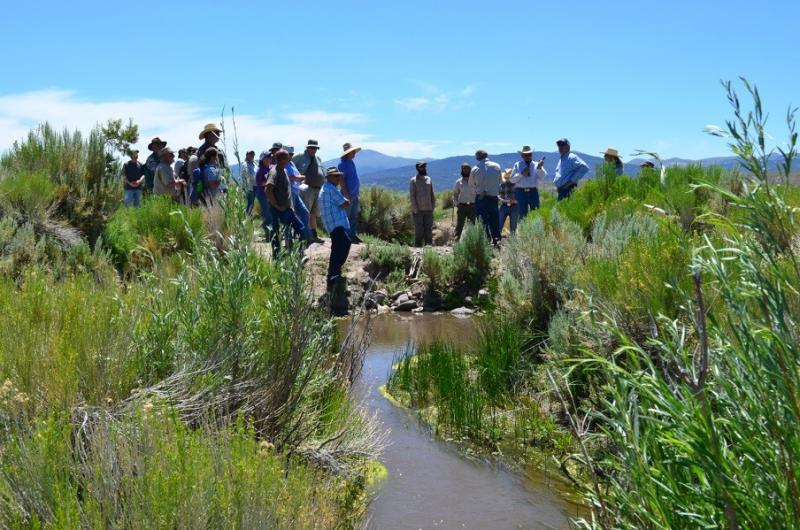Bi-State Local Area Working Group collaborates with new Nevada state park to balance people and wildlife

Dan Hottle
Reno FWO
The architects behind Nevada’s newest state park are eager to ensure that people and wildlife co-exist harmoniously in a remote and historic area of the state that has for generations been largely inaccessible by the public.
In July, members of the Bi-State Local Area Working Group representing federal, state, local, county, nonprofit and private interests met with the Walker Basin Conservancy and Nevada State Parks, a division of the state’s Department of Conservation and Natural Resources, at the newly-established Walker River State Recreation Area to discuss potential ways to maintain and improve the sagebrush ecosystem as the park moves toward opening.
More than 12,000 acres along 28 miles of the East Walker River corridor in western Nevada was recently transferred to the state from the Walker Basin Restoration Program to create the park. The land was formerly the privately-owned Pitchfork, Rafter 7 and Flying M ranch system, and was acquired by the National Fish and Wildlife Foundation for conservation purposes.
But before the park’s phased public opening that is scheduled to begin this fall, park and land managers are reaching out to wildlife biologists, ecologists and other conservation experts to help craft both short and long-term management strategies that will benefit both visitors and wildlife in the area.
“Portions of the park are habitat for extremely important species such as sage grouse, bighorn sheep, mule deer and antelope as well as fish and other riparian and upland species,” said Lee Davis, Land Stewardship Program Director for the Walker Basin Conservancy. “We’re working with partners to find creative ways to manage the park’s lands not just for a handful of these iconic species, but for the overall health of the entire ecosystem.”
Turning previously-cultivated agricultural ranch lands into lush, biodiverse wildlife sanctuaries for the benefit and enjoyment of recreationists isn’t an easy task, however. Sprawling former grazing pastures and acres of fields that were once mechanically irrigated to produce alfalfa must now be managed to help the return of native grasses, forbs and sedges that provide food and cover for nesting birds and other wildlife species. The flow of natural water must be harnessed and improved to maintain critical riparian areas.
Partners within the Bi-State working group have been collaborating for more than 20 years to figure out those very kinds of conservation management strategies. Their efforts to design and fund more than 70 different conservation projects to combat destructive wildfire, over-development, improper cattle grazing and other detrimental land management issues in the region led to keeping the Bi-State Distinct Population Segment of the Greater sage-grouse off the endangered species list.
So according to managers, developing a partnership between the federal, state and local entities of the working group, state parks and the conservancy was a logical next step.
“I appreciate the Walker Basin program and Nevada state parks reaching out to collaborate with the working group on behalf of the protection of the park’s natural resources,” said Steve Lewis, University of Nevada Cooperative Extension educator. “I am positive this effort will yield the creativity, resources and hard work that will be necessary to sustain this wild and beautiful landscape for the long term.”
The Conservancy’s primary goal for the park is habitat restoration by first stabilizing soils, maintaining its wet meadows, fighting fugitive dust and controlling invasive weeds. Considerations have also been made to continue responsible cattle grazing on park lands, as current federally-managed allotments on the property will be turned over to the state’s management when they expire over the next few years.
The goal of the state parks division is to begin development of infrastructure including road and trail improvements to support camping, hunting and fishing opportunities in a phased approach. Completion of the park’s full suite of recreational amenities including recreational vehicle hookups, cabins, camping and picnic areas and an interpretive center are scheduled to be completed during the fall of 2018.
“This incredible landscape is so wildly diverse that driving from one end of the park boundary to the other is like crossing five, rugged western states,” said Eric Johnson, Nevada State Parks administrator.
Johnson emphasized the inextricable link between recreation and conservation.
“You cannot provide a true, beneficial recreation experience for visitors in a park setting if you don’t also provide for the protection of the land’s extremely valuable natural resources; the two must be balanced hand in hand. These partnerships we’re building with one another and the work they will eventually accomplish to preserve and enhance this area will result in world-class outdoor opportunities for visitors from all over the world, and a treasure that all Nevadans can be proud of.”

